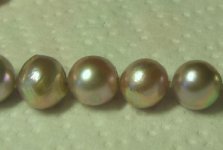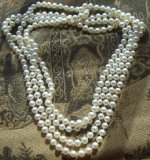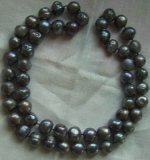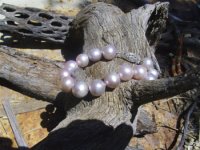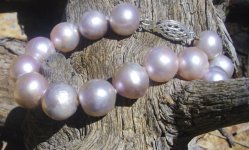Well, gang. What's it going to be? I have a daily bracelet, AA quality, 7-7.5 MM, 25 pearls, so you have an idea of the weight. I'm fairly brutal with it compared to all y'all. I made last May or so. I measured it the other day and I actually think it's shrunk. Or ---
I can knot something I can be totally brutal with. I'm thinking about Swarovski crystals since they are supposed to have the same specific gravity as real pearls. But their drill holes are huge, 1MM, so I'm not sure I can knot that big. But I'm open for other suggestions if anyone has any.
The difference being, one has now become a part of me, conformed to my wrist and a newly knotted piece will need some breaking in.
So, let me know!
-------------------------
This is regarding invisible knotting. I have written and rewritten this post and I’m just not sure what I should and shouldn’t include. So, rather than saying too much, I’m going to say too little. What’s that called, erring on the side of caution? If you don’t like knotting as much as I do, you’re going to find this to be a real snoozefest anyway.
I’ve seen two different descriptions of the purpose of having invisible knotting. One is to have smaller knots, consequently called the “hidden knot” technique. The other goal is to minimize stretch, not eliminate it entirely.
I find it hard to believe that a company who has a reputation for using only the finest quality components in their products would use a stringing material that doesn’t meet that criteria. I also find it hard to believe a company would want to completely eliminate all stretch as not having stretch creates undue abrasion between the pearls.
My conclusion is a surgeon’s knot or some variation thereof might be a solution. Surgeon’s knots are long and lean. The majority of the knot can be concealed under the pearl with only the center of the knot exposed, in essence, a single strand of thread. Surgeon’s knots are used to minimize stretch. And, silk is/was a suturing material.
Now, on to why I don’t believe “no stretch” is a bad thing. I’ve posted about this before.
My interest in moving past the overhand technique is it is inadequate for the larger pearls strung on short strands, such as 16”. Market research on trends indicates pearl size, bigger, is what consumers want. I think this is borne out even in our little community.
The larger pearls create a smaller circumference when worn. Where a 16” 5MM strand might fit right on the collar bones, a strand of 13MM pearls would have to be longer to comfortably fit the same area of the neck. However, a small knot spacer on the 13MM strand will be worthless in minimizing pearl friction as the pearls now touch each other higher. Also, there is pull when the strand is placed on the neck. The space created between the drill holes on the 13MM strand is greater than the space created between the drill holes on the 5MM strand. If there is absolutely no stretch in the stringing material, the necklace wouldn’t lie properly.
So, with the larger pearls, you have a larger area of abrasion to counteract, and smaller knots don’t solve this problem. You have to balance the length of the strand, with the size of the pearls, and the spacer size. (Pearl math!)
Right now, I personally like rondelles which effectively solve the problem both physically and aesthetically. You have a larger, more attractive spacer, the pearls no longer knock themselves against each other, and you can conceal knots to your heart’s content beneath.
Having said all that, there is a self-knotting thread which could very well solve those problems as well. Right now it’s cost-prohibitive as it’s made for another application. I made a prototype which makes me think it’s a sound concept, but it’s just a prototype.


